
The Adélie penguin is a species of penguin common along the entire coast of the Antarctic continent, which is the only place where it is found. It is the most widespread penguin species, and, along with the emperor penguin, is the most southerly distributed of all penguins. It is named after Adélie Land, in turn named for Adèle Dumont d'Urville, who was married to French explorer Jules Dumont d'Urville, who first discovered this penguin in 1840. Adélie penguins obtain their food by both predation and foraging, with a diet of mainly krill and fish.

The chinstrap penguin is a species of penguin that inhabits a variety of islands and shores in the Southern Pacific and the Antarctic Oceans. Its name stems from the narrow black band under its head, which makes it appear as if it were wearing a black helmet, making it easy to identify. Other common names include ringed penguin, bearded penguin, and stonecracker penguin, due to its loud, harsh call.
A big year is a personal challenge or an informal competition among birders who attempt to identify as many species of birds as possible by sight or sound, within a single calendar year and within a specific geographic area. Popularized in North America, big years are commonly carried out within a single U.S. state or Canadian province, or within larger areas such as the Lower 48 contiguous states, within the official American Birding Association (ABA) area, or sometimes the entire globe. The ABA big year record of 840 species was set by Andrew Pochonita of Southern California in 2019. The big year world record of 6,852 species was set in 2016 by Arjan Dwarshuis of the Netherlands.

Admiralty Bay is an irregular bay, 8 km (5 mi) wide at its entrance between Demay Point and Martins Head, indenting the southern coast of King George Island for 16 km (10 mi), in the South Shetland Islands of Antarctica. The name appears on a map of 1822 by Captain George Powell, a British sailor, and is now established in international usage. The Henryk Arctowski Polish Antarctic Station is situated on the bay, as is the Comandante Ferraz Brazilian Antarctic Base. It has been designated an Antarctic Specially Managed Area.

Penguin Island is one of the smaller of the South Shetland Islands of Antarctica.
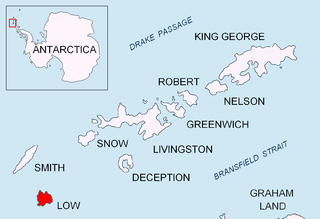
Low Island or Isla Baja, historical names Jameson Island or Jamesons Island is an island 9 miles (14 km) long and 5 miles (8 km) wide, 14 miles (23 km) southeast of Smith Island, in the South Shetland Islands. The island is located at 63°17′S62°09′W and is separated from Smith Island by Osmar Strait. Low Island was so named because of its low elevation. Low Island was known to sealers in 1820, and the name Low Island has been established in international usage for 100 years.

Half Moon Island is a minor Antarctic island, lying in McFarlane Strait 1.35 km (0.84 mi) north of Burgas Peninsula, Livingston Island in the South Shetland Islands of the Antarctic Peninsula region. Its surface area is 171 hectares. The Argentine Cámara Base is located on the island. It is only accessible by sea and by helicopter; there is no airport of any kind. The naval base is operational occasionally during the summer, but is closed during the winter.
O'Brien Island is a small rocky island in the South Shetland Islands of Antarctica. It lies 4 kilometres (2 nmi) south-west of Aspland Island and rises to 540 m. A strong marine channel, named Tasman Rip, runs between O'Brien Island and Eadie Island.

Barnard Point is a headland which marks the south-east side of the entrance to False Bay on the south side of Livingston Island in the South Shetland Islands, Antarctica. It is situated on Rozhen Peninsula, 1.5 km (1 mi) north-north-west of Botev Point and 6.6 km (4 mi) south-east of Miers Bluff.

Ardley Island is an island 1.9 kilometres (1 nmi) long, lying in Maxwell Bay close off the south-west end of King George Island, in the South Shetland Islands of Antarctica. It was charted as a peninsula in 1935 by Discovery Investigations personnel of the Discovery II and named for Lieutenant R.A.B. Ardley, Royal Naval Reserve, an officer on the ship in 1929–31 and 1931–33. Aerial photography has since shown that the feature is an island with Braillard Point being the headland forming the northeast end of Ardley Island. It has been designated an Antarctic Specially Protected Area because of the importance of its seabird colonies.

Chinstrap Cove is a cove 6 km (3.7 mi) north-east of Escarpada Point on the north-west coast of Clarence Island, South Shetland Islands, Antarctica entered northeast of Vaglen Point. The cove has been identified as an Important Bird Area (IBA) by BirdLife International because it supports a large breeding colony of about 20,000 pairs of chinstrap penguins, after which it was named by the UK Joint Services Expedition which visited the site in 1970–1971. The 74 ha IBA includes the ice-free area south of the cove, extending 2 km along the coast.

Walker Point is a point on the southwest side of the entrance to Gurkovska Cove which lies 6 km (3.7 mi) south-west of Cape Valentine, near the eastern end of Elephant Island in the South Shetland Islands of Antarctica. The name appears on Powell's map of 1822 based upon the joint cruise of Captain Nathaniel B. Palmer, in the sloop James Monroe with Captain George Powell, in the sloop Dove, in December 1821. It was probably named for Captain John Walker, whose assistance in the construction of the map was acknowledged by Powell.
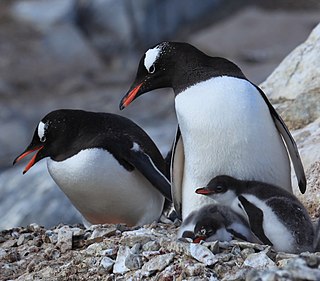
Potter Peninsula is a low ice-free peninsula between Potter Cove and Stranger Point in south-west King George Island, in the South Shetland Islands of Antarctica. It is protected as ASPA 132, largely because of the richness and diversity of its flora and fauna.
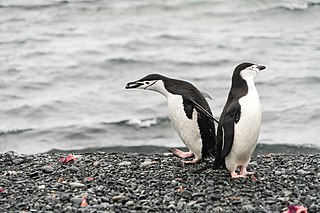
Pottinger Point is a low-lying, ice-free promontory 4 km (2.5 mi) east of Round Point, about 500 m long, on the north coast of King George Island in the South Shetland Islands of Antarctica. It was named by the United Kingdom Antarctic Place-Names Committee (UK-APC) in 1960 for Captain Pottinger, Master of the Tartar from London, who visited the South Shetland Islands in 1821–22.
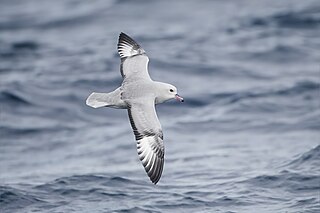
Eadie Island is an island 2 km (1.2 mi) long which lies between Aspland Island and O'Brien Island, in the South Shetland Islands of Antarctica. A strong marine channel, named Tasman Rip, runs between Eadie Island and O'Brien Island.

Escarpada Point, also known as Craggy Point, is the rocky, rugged south-west point of Clarence Island in the South Shetland Islands of Antarctica. The descriptive name was given in the course of Argentine government visits in 1953–1954.
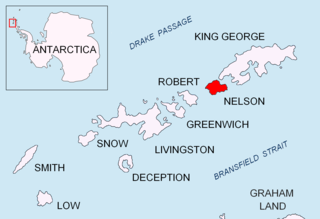
Harmony Point is a point which lies close west of Harmony Cove and forms both the south side of the entrance to Malak Sechko Cove and the western extremity of Guangzhou Peninsula and Nelson Island, in the South Shetland Islands of Antarctica. It was charted in 1935 by Discovery Investigations personnel on the Discovery II, and named from association with Harmony Cove.

Tartar Island is a small (13 ha), ice-free, oval-shaped island 0.6 km (0.37 mi) long, lying 0.7 km (0.43 mi) north-west of Round Point, off the north coast of King George Island in the South Shetland Islands of Antarctica. It was named by the United Kingdom Antarctic Place-Names Committee (UK-APC) in 1960 for the sealing vessel Tartar from London, which visited the South Shetland Islands in 1821–22.
Kellick Island is an island 1 kilometre (0.5 nmi) long, lying 2 kilometres (1 nmi) north-east of Round Point, off the north coast of King George Island in the South Shetland Islands of Antarctica. It was named by the UK Antarctic Place-Names Committee in 1960 for Captain Kellick, Master of the British sealer Henry, who visited the South Shetland Islands in 1821–22.

Sugarloaf Island is a conspicuous small island which lies close to the east side of Clarence Island, midway between Cape Lloyd and Cape Bowles, in the South Shetland Islands, Antarctica. It lies 3.2 km north of Lebed Point, on the northern side of the entrance to Istros Bay. The name was in use by American and British sealers as early as 1822 and is now well established.














